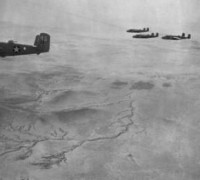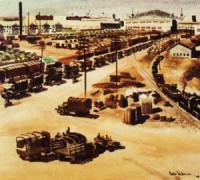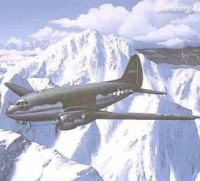WAR IS OVER - THE HOMEWARD BOUND TRAFFIC - AIR EVACUATION
1)HOMEWARD BOUND TRAFFIC
A far more significant phase of the ATC's homeward-bound traffic consisted of the air evacuation of sick, wounded, and injured men from some point outside the United States to another and from various foreign bases homeward. This service the Ferrying Command early provided on an informal and spontaneous basis, utilizing a fleet of transports moving along its several routes.
From many places sick or injured could be moved to adequate hospital facilities only by air. Patients, whether belonging to the Ferrying Command or not, were thus moved by Ferrying Command aircraft as a matter of course.
When the Ferrying Command was reorganized in June 1942 as the Air Transport Command, its formal statement of mission contained no definite reference to air evacuation. On the other hand, its general responsibility for "the transportation by air of personnel . . . for all War Department agencies, except those served by Troop Carrier units as hereinafter set forth," could certainly be construed to include the air transportation of sick and wounded personnel upon the request of any agency of the War Department.
The responsibility was made more specific when on 28 August 1942 Brig. Gen. Thomas J. Hanley, Jr., Assistant Chief of the Air Staff, A-4, directed General George to make available in transport airplanes the necessary aircraft equipment to facilitate air evacuation of personnel casualties to the United States from such bases as Alaska, Canada, Newfoundland, Greenland, Labrador, the Caribbean and other theatres wherever practicable and in accordance with priorities and approved plans of the Air Surgeon.
No special airplanes were to be provided for this evacuation, which was to be conducted in connection with the routine operations of transports. The Air Transport Command accepted this instruction as an amplification of its mission, and a series of conferences attended by medical, operations, priorities, and traffic personnel was held to explore its implications.
Little was known about the problems involved. The conferees discussed such detailed questions as the number of patients which various types of transports could accommodate, methods of fastening litters in place, the optimum levels for evacuation flights, oxygen and cabin heating for high-level flights, the medical personnel and supplies required, the priorities to be granted those personnel as well as their patients, and hospital facilities at ATC's domestic terminals. Meanwhile Troop Carrier units assigned to the active theaters had already flown large numbers of casualties from airstrips close to the front to points of relative safety.
Military Air Evacuation squadrons, consisting of medical officers, flight nurses, and medical department enlisted technicians, were trained at Bowman Field near Louisville, Kentucky, and assigned to the theaters. In March 1943, AAF Headquarters outlined the procedures which ATC should follow. As yet its service was "on a small scale for exceptional and selected cases." Thus, in January 1943, the first month for which any pertinent records are available, ATC flew eighty patients from one foreign base to another and brought thirty-three patients home to the United States. Progress was slow.
Transport aircraft were still quite scarce, and bottlenecks developed in selecting and installing for the air evacuation program suitable equipment which would not hamper the use of the planes for other purposes. As late as 28 September 1943, a forthright ATC officer reported to his immediate chief, Col. Ray W. Ireland, Assistant Chief of Staff, Priorities and Traffic that "the Air Transport Command is not prepared to transport such wounded."
By that time, nevertheless, the number of air evacuations by the ATC was increasing. From the 113 listed in January 1943, the figure rose gradually to 1,332 in October and 2,160 in December. Meanwhile Military Air Evacuation squadrons were assigned to the ATC and dispatched to some of the critical points along the overseas airways.
As experience with air evacuation was accumulated, and more of the transports were equipped with litter supports, the demand for the service increased, and it became an increasingly significant part of the ATC's mission. In December the Commanding General, AAF, was made "responsible for the development... and operation of air evacuation" not only "between overseas theaters and the United States" but also "within the United States."
This last was an additional task, and, like the rest of General Arnold's responsibilities for air evacuation, it naturally devolved largely upon ATC. As the Ferrying Division contained the ATC's most reliable source of military flight crews, it seemed the logical organization to handle the command's new duties. In April 1944, accordingly, the Ferrying Division carried out its first planned domestic flights for moving patients from one hospital to another within the Zone of the Interior.
The growing importance of air evacuation by ATC planes is most readily suggested by the following table:
NUMBER OF PATIENTS EVACUATED BY ATC
Total Domestic Foreign to Foreign Foreign to U.S.
1943 8,767 ……… 5,507 3,260
1944 117,151 38,320 47,060 31,771
1945 212,819 76,230 50,182 86,407
An individual patient may well appear three times in this tabulation, first, for instance, as an evacuee wounded, say, in the battle for Saipan, and flown from Kwajalein to Hickam Field on Oahu (3d column, "Foreign to Foreign"); next, ordinarily after an interval of treatment, from Hickam Field to Hamilton Field, California (4th column, "Foreign to US."); and, finally, from that base to the domestic general hospital nearest his home or best suited for the treatment which he required.
The number of sick and wounded men which ATC was called upon to transport depended, first, upon the number of combat casualties; second, upon the requests of theater commanders for air evacuation. If those commanders or their staff surgeons doubted the wisdom or value of moving casualties by air, and had any alternative at their disposal, they might make few requests.
Thus, as late as the first half of 1944, only a few patients were evacuated by air from Northwest Africa. Even when the commander thought well of air evacuation, he or his priority board had always to balance the need against other requirements for limited air transport space and to remember that the return to station of medical evacuation personnel would require space which might otherwise be devoted to priority cargo moving toward his theater.
On the other hand, the patient, whether evacuated by air or sea, lightened supply requirements by the ten tons needed every three months to sustain him and his attendants in an overseas hospital. In 1942 and 1943 a seemingly disproportionate share of the ATC's air evacuation flights originated in the Alaskan Wing, in much of whose territory there was no ready alternative for moving patients.
During the early months of 1944, the India-China Wing led all ATC Wings in the number of air evacuations. Relatively few of the patients involved, however, were flown all the way from China or even Assam to the United States. Most of the India-China Wing's air evacuation flights were intra theater operations which theoretically should have been carried out by theater troop-carrier planes. But since the local troop-carrier command professed inability to do the job and asked help, the wing assumed the responsibility.
The early 1944 peak of the wing's air evacuation activities reflected particularly the casualties resulting from the Japanese attack on the Imphal area and from the severe fighting in Burma. From June 1944, however, until the end of hostilities in ETO, the Southwest Pacific Area and the Pacific Ocean Areas supplied ATC with most of its overseas air evacuation traffic.
By the summer of 1944 the techniques of moving sick and wounded men by air had been standardized and ATC had acquired a large fleet of C-54 transports, its only aircraft suitable for long, over water evacuation flights. In the Pacific areas ten or more of these planes had already been equipped to carry from twenty to twenty-eight litter patients, arranged in tiers, four litters high. On the North Atlantic route, where only one C-54 had previously been so equipped, additional aircraft were now supplied with the Evans-type litter supports, in preparation for the flow of casualties which would follow the Normandy invasion.
Even in advance of the cross-Channel landings, a substantial number of patients was sent home by way of the North and Middle Atlantic routes in an effort to clear United Kingdom hospitals for the inevitable wave of invasion casualties. This served to test the detailed procedures which the North Atlantic Wing had worked out for the heavy task ahead.
On 22 June the first invasion casualties to return homeward by way of the North Atlantic airway left Prestwick; two days later they landed at Mitchel Field, New York. On 29 June the first plane exclusively loaded with invasion casualties, ten litter and four ambulatory cases, reached Mitchel Field.
Theater surgeons selected patients for air evacuation, and such theater agencies as troop-carrier aircraft and surface vessels brought them to the point of aerial embarkation. There flight surgeons assigned to the ATC screened them to determine whether they could make the journey without harm. The conclusion was ultimately reached, however, that most patients who could be moved at all (some exceptions were detailed in an official ATC memorandum) might safely be moved by air. The death of patients in the course of ATC evacuation movements was extremely rare.
The basis on which theater officers selected patients for air evacuation varied somewhat from time to time and from theater to theater, but generally the following categories were chosen: (1) those who needed treatment which could not be given in the theater; (2) patients who were expected to undergo a long convalescence and could not be returned to duty for a long time, variously estimated at from 30 to 180 days; (3) those who were expected to die but could be sent home without lessening their chances of survival. The need for emptying forward area and intermediate hospitals was mixed with humane consideration for the patients and their families.
Fork lifts, inclined ramps, and teams of litter-bearers working at different levels were used in loading litter patients into the lofty cabins of C-54 aircraft and in unloading them at their destination. Ordinarily, one or two flight nurses, specially trained in air evacuation, and a Medical Corps enlisted technician accompanied an aircraft fully or partly occupied by patients.
At intermediate points in a long flight, the medical air evacuation team was often replaced by another; when not relieved, the team, however weary, had to carry on for another leg of the trip. The condition and behavior of the patients varied greatly, of course, but the usual report was that the men were generally reluctant, even if able, to call for care or assistance and that attendants had to watch them closely to detect their needs.
The long flights were tiresome, especially to men already weakened by injuries, but the knowledge that the end of the trip would bring them to the homeland had a therapeutic value. This was true even of psychotic patients, who at a rate of five in a planeload were evacuated in considerable numbers from Southwest Pacific Area hospitals. Medical officers concluded, finally, that the speed of air evacuation made it at once the cleanest and the most comfortable method of evacuating patients.
The Air Transport Command's share in air evacuation from the European theater was in one sense a static operation, though routes and techniques changed as the months passed. For the first half-year after the Normandy landings, virtually all patients were placed on board at Prestwick. Only in December 1944 did the command begin to load wounded at Paris. In the Central and Southwest Pacific areas, however, there was constant shifting both of routes and of pickup points.
The procession of victories made yesterday's battleground tomorrow's port of aerial embarkation. The early casualties of the Tarawa campaign, moved by Navy surface vessels and troop-carrier planes to Funafuti in the Ellice Islands, were flown by ATC crews from Funafuti to Hickam Field. Tarawa in turn became the loading point for men wounded in the campaign for Kwajalein.
That island secured, it was used to start those wounded at Saipan on their flight to Hickam Field, Next, Saipan served as pickup point for men wounded, not only on the other islands of the Marianas, but also on Leyte. Shortly thereafter, in November 1944, ATC craft pushed into the combat zone itself and began loading casualties on Leyte for transportation both to Saipan and to Biak.
Casualties from Iwo Jima were picked up, beginning in February 1945, at Guam and Saipan. On 8 April, D plus 7, the Pacific Division began removing casualties from Okinawa, though conditions there were still very primitive and the struggle for the island was far from won. Manila became a starting point for air evacuation flights on 8 June, a week after Nichols Field was opened to regular C-54 traffic.
In 1944 a fifth of all the patients brought back to the United States flew by ATC aircraft. The program made a strong appeal to the imagination of a generous and sympathetic people, eager to do what they could for the boys. Air evacuation duty was not easy; the nurses and technicians who cared for the evacuees during the long hours of over water flight bore more responsibility than their counterparts at work in non-mobile hospitals.
But there was a peculiar satisfaction in the job, derived in part from the gratitude of men who appreciated the swift passage from combat or a field hospital to Oahu, or, even better, to the United States. One soldier who had just reached Hamilton Field from Saipan expressed the reaction of many: "It's just like dying and going to Heaven when you first get here. I tell you it's a wonderful feeling." What it meant to the parents, wives, and sweethearts of the wounded or ailing men requires no rhetorical embellishment and no conventional documentation.
Transcribed and formatted by David Newton for the Hyper War Foundation


